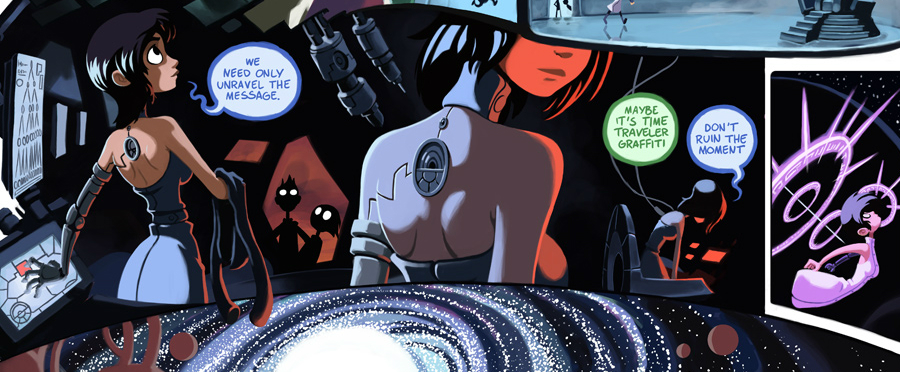
There was a moment in my comic-reading life when I realized this medium is truly powerful. When a teenaged-girl cyborg helped me stop looking at webcomics as the equivalent of daily newspaper strips and showed me how the internet opened up new storytelling potential for those artists and writers willing to forgo traditional publishing and bring their content directly to the audience. I found a way to appreciate the outliers: comics that broke rules and told stories in their own unique way so effectively that I was able to feel the hand of the creator on my back. That moment first came for me with Dresden Codak.
Wait, Who Are We Talking About?
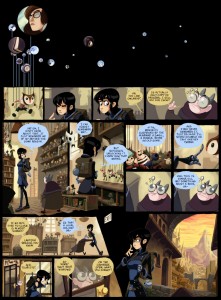
Dresden Codak isn’t a person, but the collective title for the comic work of Aaron Diaz. With a background in physics, anthropology, computer science, and art, Diaz is a creator with many interests and draws on all of them to deliver intricate comic experiences that tackle subject matter such as transhumanism, the singularity, impossible social structures, and the personal struggles of recurring protagonist Kimiko Ross. As both author and artist, Diaz offers a truly unique vision, unafraid to experiment or play with the form of his work to tell engaging, empowering, and effecting science fiction and fantasy stories.
The defining characteristic of Dresden Codak thematically is ambition. The world Aaron Diaz has created is vast and unconquerable, yet it is filled with characters who continually make the attempt. Kimiko (or Kim, as she prefers to be called) herself is defined as much by her pride and ambition as she is by her skill with technology. Although often discouraged by failure or her confrontations with authority, Diaz ensures her ambition is viewed in the perspective of the comic as a strength, and it is in her unerring drive to persevere that she ultimately succeeds. It shouldn’t need to be stated, but Diaz is openly feminist in his writing of the character, keeping Kim from becoming a puppet or object within the work, but a rounded person with actions driven by her own agency. The soaring ambition within her character certainly plays into that characterization.
Themes of ambition are also present in the construction of the comic itself. Diaz is influenced by the best, with references to the likes of Fritz Lang, Ridley Scott, and Moebius littered throughout his work. Diaz strives ambitiously to reach the level of these giants. Each page is dense with content, paying exquisite attention to the fundamentals of visual storytelling and enabling the reader to become lost in the detail of every panel. Diaz has frequently spoken about the difficulties inherent in creating such a labour intensive project, with some pages taking months of dedicated work to fully complete. This effort has been rewarded by a dedicated fanbase, supporting him through Patreon and a 2013 funding drive for the collected edition of Dresden Codak, The Tomorrow Girl, which quickly became the third highest grossing Kickstarter for a comics project ever.
So… Can I Start At The Beginning?
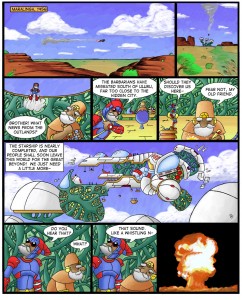
Many of the first pages in Dresden Codak play out as you’d expect from a typical webcomic in its early days, with a new creator finding their feet and experimenting with different art styles and storytelling techniques. The art can be rough around the edges and definitely doesn’t match up to what Aaron Diaz is capable of drawing today. This works better in the early pages of Dresden Codak than some other cases as Diaz hadn’t committed initially to any particular storyline. He allowed himself the creative freedom to find his voice through one page stories and often made dramatic stylistic shifts, a smart decision when starting a webcomic that began, by his own account, primarily as a tool to keep himself accountable publicly while honing his craft.
While creating pages that stand alone, Diaz was simultaneously allowing the elements that would become crucial to Dresden Codak to germinate of their own accord. These pages explore varying themes pertaining to the use of technology and ideas taken to philosophical extremes. These are also genuinely funny pages that don’t require too much knowledge of the subject matter to ‘get’, a quality which shows just how much imagination and risk Aaron Diaz is capable of. By using humour to draw his audience into esoteric concepts, he shows a strong authorial voice. Truly, Dresden Codak is a comic only Diaz could have created. While not every page is a masterpiece at this point (pages such as Operation Buffalo or Be A Zebra are definitely examples of an artist/writer still learning), the evolving thought process is there.
Where Dresden Codak has consistently shone, even in these early works, is in the layouts. Vocally influenced by contemporary webcomic A Lesson Is Learned But The Damage Is Irreversible, the evolution moves forward into pages that become sprawling masterworks. A strong understanding of visual comprehension allows Diaz’s artwork to guide the eye through unique forms which are far more interesting and creative than the standard panel format. Using as much space as necessary for each story, this comic frequently pushes the concept of the infinite canvas and allows for a real appreciation of the effort in close readings. This isn’t a storyboard layout out to be adapted later. It is true to the genuine potential of the comic page.
What’s With That Whole “Hob” Thing?
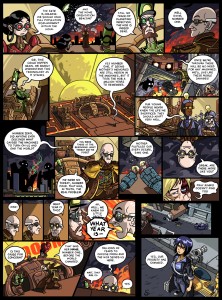
Hob is the first multipage story of Dresden Codak, a one-sided time travel adventure that populates Diaz’s world and gives firmer shape to the recurring character of Kim Ross as the comic’s protagonist. The storyline deals directly with the singularity, a theoretical point in which artificial intelligence outpaces the capability of human thought. Providing a remarkably positive outlook on the concept, Diaz’s optimism is a refreshing take in science fiction, looking at both sides but ultimately deciding to focus on the benefits of technological advancement. Featuring a pair of superhero twins and some rather unsubtle visual homages to the cast of Star Trek: The Next Generation, this arc is also indulgently delightful.
After Hob, the second period of Diaz’s one shot stories begins in a blaze of brilliance, with bookend piece Dungeons and Discourse showing how far his skills as an artist had developed. Diaz fires on all cylinders here, unafraid to make deep cuts into jokes about philosophy, ghosts, and alternate pre-history fanfictions. These are true art pieces which can often be appreciated as full and rich stories on their own merits, as well as continuing to grow the backstory and character of Kim. Lantern Season in particular is one of my all time favourite comics from any creator, creating a sad and human tale created not from a science fiction concept, but a fantasy true to the heart of the character.
Neat. How Do I Get Started?
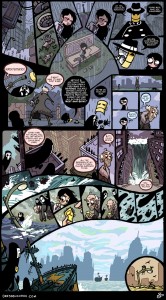
For new readers, the best place to start exploring Dresden Codak is to check out some of the one shot stories posted after Hob’s conclusion. As previously stated, Lantern Season is a personal favourite, though I can also highly recommend Onald Creely, The Professional Ghost Story or The Sleepwalkers as being among the higher quality works from this period. If Aaron Diaz’s storytelling in these pages interests you, going back and reading Hob is certainly a great option, but not at all necessary to understand the current happenings of Dresden Codak: Dark Science.
Something I intend to cover more extensively in the near future, Dark Science is an art-deco transhumanist epic that continues the story of Kim Ross as she contends with the legacy of her father in an imposing floating city steeped in secrets. Worth a review in its own right, the second part of my spotlight on Dresden Codak will continue HERE once it’s available.
In the meantime, if you’d like to support Aaron Diaz, the first arc of Dresden Codak has been collected in The Tomorrow Girl, one of the singularly most gorgeous objects in existence. For as little as $1 per month, you can also support his Patreon campaign in order to gain access to progress updates on the comics creation, exclusive blogs, and help Diaz gain enough stability to maintain a regular update schedule.
Originally posted February 12, 2016 on Talking Comics



